Oracle® Enterprise Manager Ops Center
Create and Manage Network Domains
12c Release 3 (12.3.0.0.0)
E60016-01
June 2015
This guide provides an end-to-end example for how to use Oracle Enterprise Manager Ops Center.
Introduction
A network domain is a container for managed networks and handles the relationship between the physical fabrics that support the networks and the virtualization hosts or server pools that use the networks. The fabrics provide network resources such as links and IP subnets to the network domain. Within the network domain, networks that have been discovered or specified are available for assignment. These are called public networks. Their network resources have been defined. Another type of network is dynamic, that is, the network is created when it is needed, using an IP address space available to the network domain. Because they exist only for a specific purpose and only within a specific network domain, they are called private networks.
A fabric can be a member of more than one network domain. A network domain must by supported by at least one fabric. The type of fabric defines the capabilities of networks in the network domain. To use virtual datacenters, the network domain provides private networks to the server pool. For dynamic private networks, include a fully-managed fabric or a host-managed fabric in the network domain. To use existing public networks for a virtual datacenter, you must add each network to the network domain, making it a static private network. These networks are for the exclusive use of that network domain. Because existing public networks already have an IP subnet addresses and VLAN IDs or partition keys, they are static and cannot be assigned or attached to any other object.
The Oracle Enterprise Manager Ops Center software always has a Default Network Domain and all public networks are members of it. If you have upgraded your product software, the existing managed networks are now in the Default Network Domain. A new public network becomes a member of the default network domain. If you direct the new network to a user-defined network domain, the network is also a member of that network domain. Like the default network domain, a user-defined network domain provides network resources to a server pool or virtualization host.
In this document, you create a new network domain that supports virtual datacenters.
See Related Articles and Resources for links to related information and articles.
What You Will Need
You must have the role of Network Admin to create network domains.
To create a network domain that supports a virtual datacenter, use either a fully-managed fabric or a host-managed fabric to provide its network resources.To see the available fabrics, expand Networks in the Assets pane. Select Fabrics. For each fabric, the Dashboard in the center pane includes a Management Capability field. You can change an unmanaged Ethernet fabric to a host-managed fabric, using the Assign VLAN ID Range action to create VLAN IDs.
Although the network domain is providing the networks to the server pools, this is a logical association using VLAN IDs or partition keys. To use the network resources, each physical server that supports the virtualization hosts in the server pool must have a physical connection to each fabric in the network domain.
Create a New Network Domain
This task defines the new network domain and includes the fabrics that support its networks.
-
Expand Networks in the Navigation pane.
-
The Standard views shows Networks.
The Default Network Domain is selected.
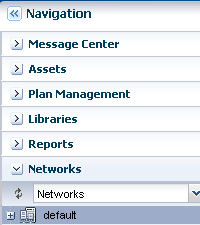
Description of the illustration nav_nw.png
-
Click Create Network Domain in the Actions pane.
-
In the Identify Network Domain pane, enter the name and description of the network domain. You can also add tags.

Description of the illustration create_networkdomain_step1a.png
-
In the Add Fabrics step, choose at least one fully-managed fabric or a host-managed fabric.
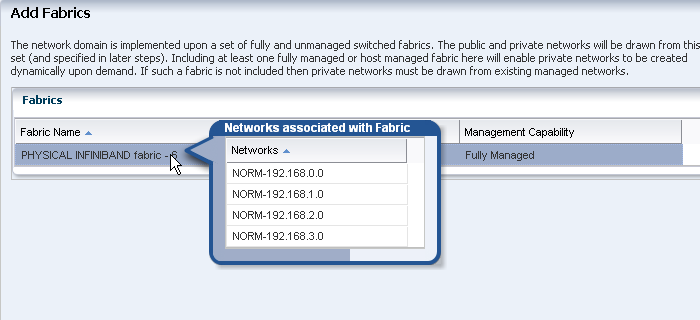
Description of the illustration create_networkdomain_step2a.png
-
In this step, you set the maximum number of dynamic private networks that can be in use simultaneously. Because it is not possible to decrease the number of networks in a network domain after you create it, enter a low number in the Network Creation Limit field.
A private network uses an IP address from the pool of available IP addresses in the network domain. To exclude IP addresses that your organization is using for other purposes, specify them in the Reserved IP Address Ranges table. These addresses will not be available to dynamic private networks.
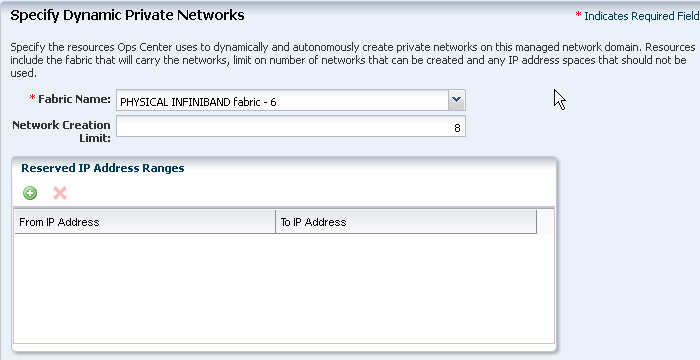
Description of the illustration create_networkdomaindyn_3a.png
-
In the Associate Networks step, you can add existing networks to the new network domain.
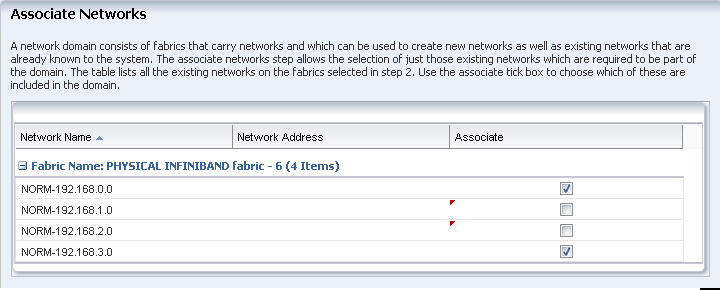
Description of the illustration create_networkdomain_step5a.png
-
Review and click Finish.
When the job is completed, the new network domain is listed in the Navigation pane.
Associating a Network Domain with a Server Pool
-
Expand Assets in the Navigation pane.
-
Select the server pool.
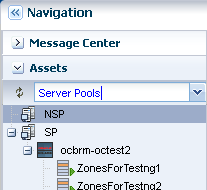
Description of the illustration nav_sp.png
-
Click Associate Network Domain in the Actions pane.
-
Select a network domain from the drop-down list.

Description of the illustration assoc_networkdomain_step1a.png
-
The Specify Physical Interfaces table shows each server in the server pool. For each one, select its physical connection to the fabric.
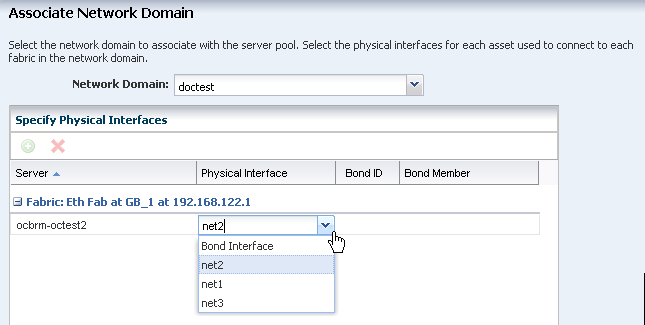
Description of the illustration assoc_networkdomain_step2a.png
-
If the physical interface is an IPMP group or a link aggregation, specify the bond ID and the bond member that the server uses. The Configure Bonding step is displayed, showing the server and the Bond ID.
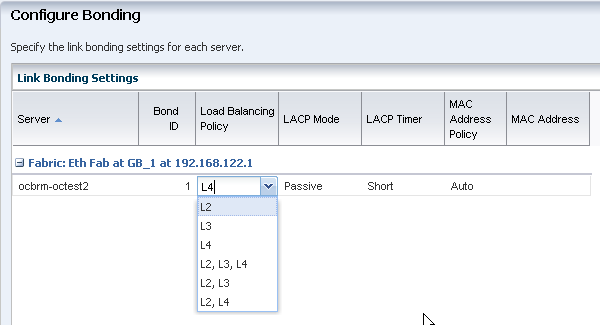
Description of the illustration assoc_networkdomain_bond.png
Specify the characteristics of the IPMP group or link aggregation or accept the default values.
Click Next.
-
Review the summary and click Finish.

Description of the illustration assoc_networkdomain_step3a.png
When the job is completed, the server pool is associated with the network domain and, through the network domain, its fabrics.
What's Next?
If a virtual datacenter that relies on this network domain is unable to create vnets, you can increase the limit of private networks it can provide simultaneously.
If your organization uses this network domain for a specific purpose, for example, to support the server pool used exclusively by one department, you can edit the attributes of the network domain to identify this purpose.
Related Articles and Resources
See the following for more information:
-
Configure Networksin Oracle Enterprise Manager Configure Reference. -
Networks for Virtualizationin Oracle Enterprise Manager Virtualize Reference for information about network resources for virtual assets. -
Server Poolsin Oracle Enterprise Manager Virtualize Reference for information about managing network and storage resources for virtual assets.
See the Deploy Networks Workflow in Deploy How To library at http://docs.oracle.com/cd/E59957_01/nav/deploy.htm
Documentation Accessibility
For information about Oracle's commitment to accessibility, visit the Oracle Accessibility Program website at http://www.oracle.com/pls/topic/lookup?ctx=acc&id=docacc.
Oracle customers that have purchased support have access to electronic support through My Oracle Support. For information, visit http://www.oracle.com/pls/topic/lookup?ctx=acc&id=info or visit http://www.oracle.com/pls/topic/lookup?ctx=acc&id=trs if you are hearing impaired.
Oracle Enterprise Manager Ops Center Create and Manage Network Domains, 12c Release 3 (12.3.0.0.0)
E60016-01
Copyright © 2007, 2015, Oracle and/or its affiliates. All rights reserved.
This software and related documentation are provided under a license agreement containing restrictions on use and disclosure and are protected by intellectual property laws. Except as expressly permitted in your license agreement or allowed by law, you may not use, copy, reproduce, translate, broadcast, modify, license, transmit, distribute, exhibit, perform, publish, or display any part, in any form, or by any means. Reverse engineering, disassembly, or decompilation of this software, unless required by law for interoperability, is prohibited.
The information contained herein is subject to change without notice and is not warranted to be error-free. If you find any errors, please report them to us in writing.
If this is software or related documentation that is delivered to the U.S. Government or anyone licensing it on behalf of the U.S. Government, then the following notice is applicable:
U.S. GOVERNMENT END USERS: Oracle programs, including any operating system, integrated software, any programs installed on the hardware, and/or documentation, delivered to U.S. Government end users are "commercial computer software" pursuant to the applicable Federal Acquisition Regulation and agency-specific supplemental regulations. As such, use, duplication, disclosure, modification, and adaptation of the programs, including any operating system, integrated software, any programs installed on the hardware, and/or documentation, shall be subject to license terms and license restrictions applicable to the programs. No other rights are granted to the U.S. Government.
This software or hardware is developed for general use in a variety of information management applications. It is not developed or intended for use in any inherently dangerous applications, including applications that may create a risk of personal injury. If you use this software or hardware in dangerous applications, then you shall be responsible to take all appropriate fail-safe, backup, redundancy, and other measures to ensure its safe use. Oracle Corporation and its affiliates disclaim any liability for any damages caused by use of this software or hardware in dangerous applications.
Oracle and Java are registered trademarks of Oracle and/or its affiliates. Other names may be trademarks of their respective owners.
Intel and Intel Xeon are trademarks or registered trademarks of Intel Corporation. All SPARC trademarks are used under license and are trademarks or registered trademarks of SPARC International, Inc. AMD, Opteron, the AMD logo, and the AMD Opteron logo are trademarks or registered trademarks of Advanced Micro Devices. UNIX is a registered trademark of The Open Group.
This software or hardware and documentation may provide access to or information about content, products, and services from third parties. Oracle Corporation and its affiliates are not responsible for and expressly disclaim all warranties of any kind with respect to third-party content, products, and services unless otherwise set forth in an applicable agreement between you and Oracle. Oracle Corporation and its affiliates will not be responsible for any loss, costs, or damages incurred due to your access to or use of third-party content, products, or services, except as set forth in an applicable agreement between you and Oracle.